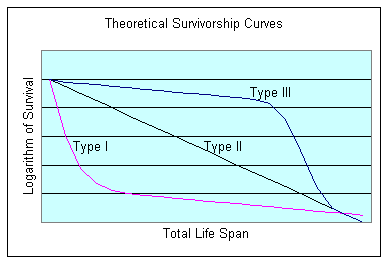Explain the Mortality and Survivorship Curves?
Mortality : Just as a population has a birth rate, so does it have a death rate. A populations rate of death, or the number of deaths within a given time frame, is referred to as its mortality. Mortality can occur at any stage of life, even in the embryonic stages. As such, death rates do differ among the species in terms of which particular stage in life most deaths occur.
In some species, higher death rates are realized in younger stages of life such as sea turtles, octopuses, frogs, or larval stages of insects. In these examples, large numbers of very young individuals are picked off and eaten by predators. This may help to explain why they reproduce in such large numbers it may be a way to increase the odds of at least some surviving to carry on the species. In other species such as the larger mammals, there tends to be higher levels of parental care and nurturing for longer periods of time. So in these animals, mortality tends to be postponed until later stages of life.

The above differences then account for differences in survival. In situations where large numbers of young die early in life, the populations experience a steep decline early on, sustaining populations of low numbers for the normal life span. In the cases where very few individuals die early, the population numbers maintain a fairly even level until the later years, where the population undergoes a steep decline. Populations that have a constant death rate, the population can be seen to have a constant slope downward in numbers. These three types of theoretical survivorship curves can be graphed as seen below.